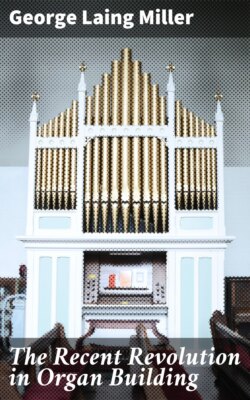Читать книгу The Recent Revolution in Organ Building - George Laing Miller - Страница 15
На сайте Литреса книга снята с продажи.
Fig. 3. The Pneumatic Lever
ОглавлениеTable of Contents
The organ touch could now be made as light as that of a pianoforte, much lighter than ever before.
This epoch-making invention, introduced in 1832, rendered possible extraordinary developments. It was at first strangely ignored and opposed. The English organ-builders refused to take it up. Barker was at length driven to France, where, in the person of Aristide Cavaillé-Coll, he found a more far-seeing man.
After Cavaillé-Coll had fully demonstrated the practical value of Barker's invention, Willis and others joined in its development, and they contemporaneously overcame all difficulties and brought the pneumatic action into general favor.
This process, of course, took time, and up to about fifty years ago pneumatic action was found only in a few organs of large calibre.
The recent revolution in organ building and in organ tone, of which this book treats, was founded upon the pneumatic and electro-pneumatic actions invented by Barker.[2]
It is safe to say that the art of organ building has advanced more during the last fifty years than in any previous three centuries. We are literally correct in saying that a veritable revolution has already been effected—and the end is not yet.
As leaders in this revolutionary movement, three names stand out with startling prominence—Henry Willis, Aristide Cavaillé-Coll and Robert Hope-Jones.
Others have made contributions to detail (notably Hilborne L. Roosevelt), but it is due to the genius, the inventions and the work of those three great men that the modern organ stands where it does to-day.
We propose:
1. To enumerate and describe the inventions and improvements that have so entirely transformed the instrument;
2. To trace the progress of the revolution in our own country; and,
3. To describe the chief actors in the drama.
In the middle of the last century all organs were voiced on light wind pressure,[3] mostly from an inch and a half to three inches. True, the celebrated builder, William Hill, placed in his organ at Birmingham Town Hall, England, so early as 1833, a Tuba voiced on about eleven inches wind pressure, and Willis, Cavaillé-Coll, Gray and Davison, and others, adopted high pressures for an occasional reed stop in their largest organs; yet ninety-nine per cent. of the organs built throughout the world were voiced on pressures not exceeding three and one-half inches.
In those days most organs that were met with demanded a finger force of some twenty ounces before the keys could be depressed, when coupled, and it was no uncommon thing for the organist to have to exert a pressure of fifty ounces or more on the bass keys. (The present standard is between three and four ounces. We are acquainted with an organ in New York City which requires a pressure of no less than forty ounces to depress the bass keys.)
The manual compass on these organs seldom extended higher than f2 or g3, though it often went down to GG.[4]
It was common to omit notes from the lower octave for economy's sake, and many stops were habitually left destitute of their bottom octaves altogether. Frequently the less important keyboards would not descend farther than tenor C.[5]
The compass of the pedal board (when there was a pedal board at all) varied anywhere from one octave to about two and a quarter octaves. The pedal keys were almost invariably straight and the pedal boards flat.
